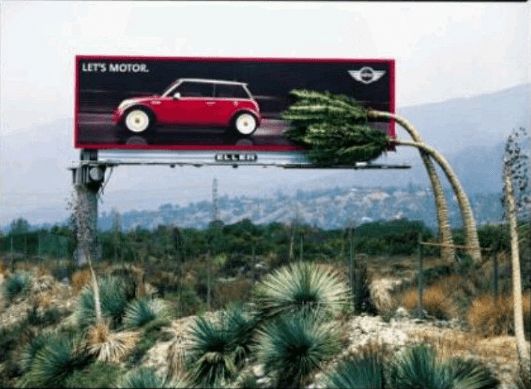Guerrilla marketing describes a special form of marketing that relies heavily on the surprise effect. It is often characterized by the principle that a small advertising impact can have a great advertising effect. The idea of guerrilla marketing goes back to marketing professional Jay C. Levinson, who developed the basic concept in the 1980s. Guerrilla tactics are particularly suitable for online marketing measures since high virality can be achieved here, for example, by sharing via social networks.
Guerrilla marketing is an innovative communication strategy that thrives on surprise effects. In guerrilla marketing, creative ideas are staged particularly eye-catching. With this, advertisers try to convey their advertising messages through unconventional marketing measures. Guerrilla marketing often only uses a manageable budget, with which the greatest possible effect should nevertheless be achieved.
The US marketer Jay Conrad Levinson established the word creation, guerrilla marketing, in the 1980s. The term guerrilla marketing is derived from the military language. Guerrilla warfare is a type of warfare aimed at weakening the enemy in a targeted manner using unconventional tactics. Guerrilla marketing also aims to gain an advantage over the competition through atypical measures. Guerrilla marketing is assigned to below-the-line communication since it does not usually use traditional methods, but rather unconventional measures that address consumers directly and personally.
What is the Aim of Guerilla Marketing?
The declared goal of guerrilla marketing is to increase the reach of advertising measures. Classic advertising has been struggling for years with a declining reach, which is not least due to the enormous overstimulation with which consumers are confronted. Every day, between 2,500 and 10,000 different advertisements and formats come to the attention of consumers. To stand out from the crowd and make your voice heard is the goal of a properly designed guerrilla marketing strategy.
How Does Guerilla Marketing Work?
In guerrilla marketing, advertising is placed on objects and in places where consumers do not necessarily expect advertising. The possibilities for advertising media are very diverse. They range from advertising on everyday objects such as beer coasters or escalators to installations and street actions (such as flash mobs). Innovative forms of advertising are intended to address the target audience emotionally, for example, because they have to laugh, are surprised, or are shocked.
Guerrilla marketing can have different goals. As a rule, the aim is to make products or brands known or to strengthen their image.
This form of marketing has often been used in the past to market new films. Guerilla marketing is also a common advertising method in the field of sports. Because unusual campaigns can attract a lot of attention even on a small budget, experts recommend guerilla marketing not only to large brands but also to small and medium-sized companies and the self-employed.

Some examples of Guerilla Marketing are below:
- The chocolatier Lindt provided his company car with rabbit ears and a nose, alluding to the golden Lindt Easter bunny.
- Nivea used a public sofa with half a smooth and uneven seat to illustrate the feeling of cellulite-free skin with care products.
- A gym equipped the benches in the bus shelter with a scale and showed the waiting people how urgently the next sports unit was actually necessary.
- As an advertisement for the cinema film “Spider-Man 2”, a men’s urinal was installed at a height of several meters—perfectly suitable for gentlemen who like climbing.
- McDonald’s converted a crosswalk into a large french fries bag.
- Nike staged an 80-year-old runner in Nike equipment in a media-sponsored marathon sponsored by Adidas and thus weakened the advertising impact of the actual sponsor, Adidas
- When many customers switched to rental cars due to rail strikes, the car rental company Sixt GDL boss Claus Weselsky promptly declared employee of the month—and thus caused a lot of conversation.
You also may want to read some related Marketing Guidelines.
- Return of Investment Definition and Importance
- NeuroMarketing and Principles
- Flywheel Marketing and Its Effects on Revenue
- Eye-tracking and Importance for UX
- Community Management for Better Customer Loyalty
- What is Page Impression?
- What is Conversion Rate Optimization?
What are the Risks of Guerilla Marketing?
At first glance, guerrilla marketing offers very good opportunities for a large advertising effect on a small budget. The obvious risks are often overlooked. The problem is that the viral effect of a guerrilla marketing campaign cannot be controlled. If the campaign is a surefire success and spreads virally, it can develop in all directions, including negative ones.
If the target group reacts to the chosen advertising mechanism annoyed or without understanding, in the worst case a campaign can lead to a shit storm and consequently to image damage and loss of sales. Therefore, when planning a guerilla marketing campaign, all possible scenarios and the reactions required in an emergency should be run through. Solid tracking and monitoring of user behavior are also important. This data makes it easier to draw conclusions about the reason for success or failure.
What are the Guerrilla marketing Tools and Kinds?
Guerrilla marketing is divided into different areas, the demarcation of which is partially blurred. As a rule, one assigns ambient marketing, ambush marketing, sensation marketing, and viral marketing to guerrilla marketing.
1. Ambient Marketing
Ambient marketing refers to surprising product presentations that consumers reach in their normal environment. This is about the extraordinary implementation of outdoor advertising in public spaces. Ambient marketing can e.g., B. Designate innovative advertising at the airport, on buses or trains, or in the catering trade. Possible advertising media are, for example, beer mats, postcards, or toilet seats in pubs.
2. Ambush Marketing
Ambush marketing is also known as free-rider marketing. Attention to a topic or event is used to showcase your own brand. Ambush marketing is also often used at large events to carry out an image transfer to your own brand.
Ambush marketing is controversial because, with this form of advertising, an association with an event crept up, so to speak.
3. Sensation Marketing
In sensation marketing, unusual campaigns or spectacular installations are carried out, for example, at the point of sale. Multipliers such as promoters are always used. Examples of sensational marketing include surprising fashion shows or flash mobs in the pedestrian zone.
4. Viral Marketing
Viral marketing is also assigned to guerrilla marketing. The aim is to get as much attention as possible in the respective target group. Viral Marketing pursues the goal of spreading content virally, for example, by recommending or sharing it personally via word of mouth or online via social media.
Examples of campaigns in guerrilla marketing
Many companies use guerrilla marketing campaigns to present their brands or products in an eye-catching manner. For example, the film “King Kong” was advertised with a giant footprint on the beach. In the run-up to the low-budget film “The Blairwitch Project”, the mysterious disappearance of students was staged in a witch’s forest. The Mini brand has always found new opportunities in the past to present itself with guerrilla marketing.

Success factors of guerrilla marketing
In addition to a creative idea, good planning and preparation are particularly important in guerrilla marketing campaigns. It is also crucial for success that the guerrilla campaign fits the brand and the target group (“brand fit”). In addition, points of contact should be created so that consumers can deal directly with the respective action. For successful guerrilla marketing, it is also advisable to network the measures cross-media and to involve consumers in the campaign. In order to allow the campaign to go viral, the target group should be encouraged to post content on the Internet (e.g., upload photos to Pinterest).
Conclusion:
Guerilla marketing is a particularly creative advertising method in which products or brands are surprisingly staged. Various instruments are assigned to guerilla marketing, including ambient marketing, sensation marketing, ambush marketing, and viral marketing. The transitions of these sub-areas are fluid.
In the struggle for consumer attention, guerrilla marketing offers the opportunity to address the target group with advertising where it does not expect it and thus stands out positively from the competition. To achieve marketing goals, emotional triggers such as humor are often used in guerrilla marketing. Through emotional experiences, advertising should be perceived more by consumers and be better remembered.
If you want to learn more about Emotions roles for Purchase Process for Consumers, you can read our “What is Neuromarketing” article.
Guerrilla marketing campaigns can attract a lot of attention in a positive sense and spread virally. However, guerrilla marketing also harbors risks, for example in the case of daring campaigns such as ambush marketing or inadequate brand fit. If companies overshoot the target in guerrilla marketing, this can trigger a shit storm in social media. Guerrilla marketing is also not uncommon in legal gray areas.
What is the Relationship between SEO and Guerilla Marketing?
Holistic SEO’s first principle is creativity. If a Brand has a successful guerilla marketing campaign, Holistic SEO can use this opportunity to get more visibility on the different Search Engines. From YouTube, Facebook, or Google and Giphy, every kind of related content can be configured according to the different user and buyer persona to create awareness. Changing meta tags, page layout, and checking the searched queries related to the campaign and user behavior metrics are the sections for the SEO in Guerilla Marketing. Also, the target query group or the topic can be used in guerilla marketing so that people can search the brand or the brand’s service with those generic and branded queries. If a Search Engine realizes that your brand is the user’s main target for those queries and topics, it will create higher ranks on Google or other kinds of Search Engines.
Using hashtags on the Social Media related to the targeted queries or creating GIFs and publishing them through Twitter or Giphy, organizing the community for making trend climbing in favor of the brand are related to the Guerilla Marketing and Holistic SEO intersection. Also, calculating the rank differences, log analysis differences and preparing the server for big connection loads along with the developer team can be counted here as the responsibilities of Holistic SEO.
As Holistic SEOs, we will continue to improve our guidelines for a better understanding of the web ecosystem.
- Sliding Window - August 12, 2024
- B2P Marketing: How it Works, Benefits, and Strategies - April 26, 2024
- SEO for Casino Websites: A SEO Case Study for the Bet and Gamble Industry - February 5, 2024


